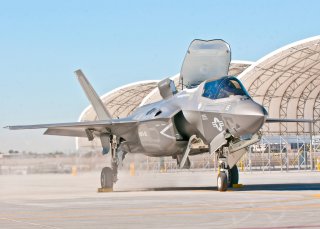Germany Should Be the Next European Country to Embrace the F-35
Both Germany and NATO would benefit if Berlin joined the F-35 club.
Switzerland and Finland have joined the F-35 club, a development that will greatly strengthen any future integrated European force structure. Denmark, Norway, Poland, Italy, and the United Kingdom have all made measurable advancements with their respective F-35 programs. Notably, British F-35s operated with U.S. F-35Bs onboard the Royal Navy’s HMS Queen Elizabeth carrier. Denmark recently received its first F-35A Lightning II, and the Netherlands declared in December that its F-35 fleet is operationally capable. All of these recent developments have significantly changed the deterrence equation in Europe. This raises an important question: which European country will join the F-35 club next?
What About Germany?
Germany is a NATO member that could greatly contribute to multinational interoperability if it embraced the F-35. However, over the course of the last several years, multiple reports have stated that German decision-makers prefer the Eurofighter Typhoon. One potential reason for this could be Germany’s interest in sustaining European manufacturing of Luftwaffe fighter jets.
A previous story in the National Interest quotes experts and decision-makers who highlighted the jobs that would be generated by sticking with the Eurofighter. However, recent developments could impact the equation for Germany. First, Lockheed Martin continues to expand its forward maintenance, construction, and vendor base within Europe to support its growing number of F-35 customers. This opens up the possibility of European-based vendors subcontracting for Lockheed and creating thousands of jobs.
Beyond any potential economic impact, there are a growing number of strategic and tactical reasons why Germany might benefit from joining a multinational F-35 force. The F-35’s Multifunction Advanced Data Link (MADL) provides multinational networking advantages by offering secure connectivity between F-35s from different countries. This massively improves sensor-to-shooter times, surveillance data networking, and targeting information transmission. In addition, emerging innovations will improve connectivity between 4th and 5th-generation aircraft. Enhanced connectivity will allow these fighters to create a meshed network that is able to respond to emerging threats in real-time.
Finally, much can be said about the capability and performance differences between the Eurofighter Typhoon and the F-35. The F-35 may be more capable in terms of stealth characteristics, sensor range and fidelity, computing, and weapons applications. In addition to enhancing Germany’s interoperability with its NATO allies, a German F-35 fleet would introduce a new level of technological sophistication and upgradeability for the Luftwaffe. Current thinking suggests that the F-35, with its ability to receive software upgrades that expand its sensing and communications technology, may remain impactful well into the 2070s.
Kris Osborn is the Defense Editor for the National Interest. Osborn previously served at the Pentagon as a Highly Qualified Expert with the Office of the Assistant Secretary of the Army—Acquisition, Logistics & Technology. Osborn has also worked as an anchor and on-air military specialist at national TV networks. He has appeared as a guest military expert on Fox News, MSNBC, The Military Channel, and The History Channel. He also has a Master's Degree in Comparative Literature from Columbia University.
Image: Reuters.

